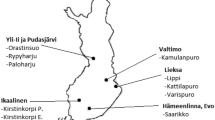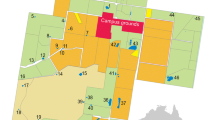Abstract
We investigated factors influencing dabbling duck (Anas spp.) brood densities on 9 created wetlands, arranged in 4 clusters on the National Elk Refuge in western Wyoming. Because dabblers are limited by the depth they can reach while up-ending, and created wetlands were between 1.5–2.5 m deep, we examined the significance of invertebrate density in the top 25 cm of the water collumn and in the entire water column where brood use occurs. Total invertebrate, nekton, and zooplankton density in the entire water column measured in 1992 accounted for between 59%, 61%, and 73%, respectively, (P<0.05) of the variation in brood density among wetlands that year. No variable measured in the top 25 cm of the water column accounted for variation in brood densities on wetlands. We suggest that vertical migrations in the water column make most invertebrates accessible to dabbler hens and broods.
Similar content being viewed by others
Literature Cited
American Ornithologist’ Union. 1983. Check-list of North American Birds. 6th edition. Washington, DC, USA.
Barzen, J.A. and J.R. Serie. 1990. Nutrient reserve dynamics of breeding canvasbacks. Auk 107:75–85.
Belanger, L. and R. Couture. 1988. Use of man-made wetlands by dabbling duck broods. Journal of Wildlife Management 52:718–723.
Bellrose, F.C. 1980. Ducks, Geese, and Swans of North America. Third ed. Stackpole Books, Harrisburg, PA, USA.
Brown, M. and J.J. Dinsmore. 1986. Implications of marsh size and isolation for marsh bird management. Journal of Wildlife Management 50:392–397.
Cooper, C.B. 1994. Dabbling duck foraging sites on the National Elk Refuge, Wyoming. Masters Thesis. University of Wyoming, Laramie, WY, USA.
Department of Commerce, USA. 1982. Climatology of the U.S. #81 by state: monthly normals of temperature, precipitation, and heating and cooling degree days 1951–1980. National Oceanic and Atmospheric Administration, Environmental Data and Information Service, National Climate Center, Washington, DC, USA.
Downing, J.A. 1986. A regression technique for the estimation of epiphytic invertebrate populations. Freshwater Biology 16:161–173.
Dwyer, T.J., G.L. Krapu, and D.M. Janke. 1979. Use of prairie pothole habitat by breeding mallards. Journal of Wildlife Management 43:526–531.
Fassett, N.C. 1985. A Manual of Aquatic Plants. Second ed The University of Wisconsin Press, Madison, WI, USA.
Folk, C., K. Hudec, and J. Toufar. 1966. The weight of the mallard,Anas platyrhynchos, and its changes in the course of the year. Zoological Listing 15:249–260.
Gatti, R.C. 1983. Incubation weight loss in the mallard. Canadian Journal of Zoology 61:565–569.
Harris, H.L. 1970. Evidence of stress response in breeding bluewinged teal. Journal of Wildlife Management 34:747–755.
Hudson, M.S. 1983. Waterfowl production on three age classes of stock wetlands in Montana. Journal of Wildlife Management 47: 112–117.
Hunter, M.L., Jr., J.W. Witham, and H. Dow. 1984. Effects of a carbaryl-induced depression in invertebrate abundance on the growth and behavior of American black duck and mallard ducklings. Canadian Journal of Zoology 62:452–456.
Joyner, D.E. 1980. Influence of invertebrates on wetland selection by ducks in Ontario. Journal of Wildlife Management 44:700–705.
King, J.R. 1973. Energetics of reproduction in birds. p. 78–108.In D.S. Rarner (ed.) Breeding biology of birds. National Academy of Science, Washington, DC, USA.
Krapu, G.L. 1981. The role of nutrient reserves in mallard reproduction. Auk 98:29–38.
Krapu, G.L. and K.J. Reinecke. 1992. Foraging ecology and nutrition. p. 1–29.In B.D.J. Batt, A.D. Afton, M.G. Anderson, C.D. Ankney, D.H. Johnson, J.A. Kadlec, and G.L. Krapu (eds.) Ecology and Management of Breeding Waterfowl. University of Minnesota Press, Minneapolis, MN, USA.
Lokemoen, J.T. 1973. Waterfowl production on stock-watering wetlands in the northern plains. Journal of Range Management 26: 179–184.
McNaught, D.C. and A.D. Hasler. 1964. Rates of movement of populations ofDaphnia in relation to changes in light intensity. Journal of Fisheries Research Board of Canada 21:291–318.
Merritt, R.W. and K.W. Cummins. 1988. An Introduction to the Aquatic Insects of North America. Second ed. Kendall/Hunt Publishing Co., Dubuque, IA, USA.
Mulhern, J.H., T.D. Nudds, and B.R. Neal. 1985. Wetland selection by mallards and blue-winged teal. Wilson Bulletin 97:473–485.
Murkin, E.J., H.R. Murkin, and R.D. Titman. 1992. Nektonic invertebrate abundance and distribution at the emergent vegetation-open water interface in the Delta marsh, Manitoba, Canada. Wetlands 12:45–52.
Needham, J.G. and P.R. Needham. 1962. A Guide to the Study of Fresh-water Biology. Fifth ed. McGraw-Hill Publishing Co., New York, NY, USA.
Noyes, J.H. and R.L. Jarvis. 1985. Diet and nutrition of breeding female redhead and canvasback ducks in Nevada. Journal of Wildlife Management 49:203–211.
Nudds, T.D. 1983. Niche dynamics and organization of waterfowl guilds in variable environments. Ecology 64:319–330.
Owen, M. 1980. Wild Geese of the World: Their Life History and Ecology. Batsford Press, London, UK.
Poysa, H. 1989. Foraging patch dynamics in the teal (Anas crecca): effects of sociality and search method switching. Behaviour 110: 306–318.
Reinecke, K.L. 1979. Feeding ecology and development of juvenile black ducks in Maine. Auk 96:737–745.
Rotella, J.J. and J.T. Ratti. 1992. Mallard brood movements and wetland selection in Southwestern Manitoba. Journal of Wildlife Management 56:508–515.
Serie, J.R. and G.A. Swanson. 1976. Feeding ecology of breeding gadwalls on saline wetlands. Journal of Wildlife Management 40: 69–81.
Stewart, R.E. and H.A. Kantrud. 1973. Ecological distribution of breeding waterfowl populations in North Dakota. Journal of Wildlife Management 37:39–50.
Swanson, G.A. 1977. Diel food selection by Anatinae on a wastestabilization system. Journal of Wildlife Management 41:226–231.
Swanson, G.A. 1978. A simple lightweight core sampler for quantitating waterfowl foods. Journal of Wildlife Management 42:426–428.
Swanson, G.A. and M.I. Meyer. 1973. The role of invertebrates in the feeding ecology of Anatinae during the breeding season. p. 143–185.In Water Habitat Management Symposium. Atlantic Waterfowl Council, Moneton, NB, Canada.
Thorp, J.H. and A.P. Covich. 1991. Ecology and Classification of North American Freshwater Invertebrates. Academic Press, Inc. Harcourt Brace Jovanovich, Publishers, San Diego, CA, USA.
Voigts, D.K. 1976. Aquatic invertebrate abundance in relation to changing marsh vegetation. American Midland Naturalist 95:313–322.
Weller, M.W. and L.H. Fredrickson. 1973. Avian ecology of a managed glacial marsh. Living Bird 12:269–291.
Weller, M.W. and C.E. Spatcher. 1965. Role of habitat in the distribution and abundance of marsh birds. Special Report # 43, Iowa State University, Agricultural Home Economic Experimental Station, Ames, IA, USA.
Author information
Authors and Affiliations
Rights and permissions
About this article
Cite this article
Cooper, C.B., Anderson, S.H. Significance of invertebrate abundance to dabbling duck brood use of created wetlands. Wetlands 16, 557–563 (1996). https://doi.org/10.1007/BF03161346
Received:
Revised:
Accepted:
Issue Date:
DOI: https://doi.org/10.1007/BF03161346




